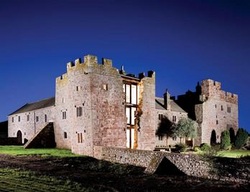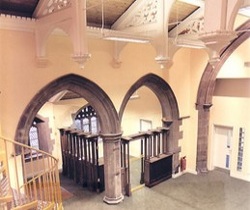Heritage Buildings with a Change of Use
Blencowe Hall, Penrith

This magnificent manor house has acquired not one but two defensive peel towers over the centuries. One of these has remained a habitable part of the structure, but the other, the southern tower, had fallen into ruin long before the new owners bought the house. Inside it was open to the sky and fireplaces were still visible several storeys up, showing the location of the original rooms.
From the outside, the tower offers dramatic and intriguing clues to its history, including an enormous gash in the stonework – often said to be the result of an attack on the building by Parliamentary forces in the 1640s, but more probably the result of soft ground and underground water. The owners wanted the site, both a scheduled monument and Grade I listed building, to be habitable, wishing to create some holiday accommodation within it.
The gash in the masonry that made the ruin so spectacular has been retained, in an eye-catching form. It remains as dramatic a sight as ever but now has behind it inset glazing and balconies. Inside, new rooms have been created; the stranded fireplaces once more relate to floors and hearths, and a bold and visually arresting solution has been found to give new life to a unique part of England’s architectural history.
This case study shows that by changing the use of its intended purpose, the benefits can be far more rewarding. By implementing accomodation within, this starts to generate revenue in which to keep the building maintained and also will become a more popular tourist spot for enthusiasts.
By utilising traditional methods and materials and merging these with modern techniques and ideas of design, the landmark will possibly remain longer than it would have left to deteriorate as a ruin.
Further reading & Information
http://www.english-heritage.org.uk/professional/advice/conservation-principles/constructive-conservation/constructive-conservation-in-practice/blencowe-hall/
From the outside, the tower offers dramatic and intriguing clues to its history, including an enormous gash in the stonework – often said to be the result of an attack on the building by Parliamentary forces in the 1640s, but more probably the result of soft ground and underground water. The owners wanted the site, both a scheduled monument and Grade I listed building, to be habitable, wishing to create some holiday accommodation within it.
The gash in the masonry that made the ruin so spectacular has been retained, in an eye-catching form. It remains as dramatic a sight as ever but now has behind it inset glazing and balconies. Inside, new rooms have been created; the stranded fireplaces once more relate to floors and hearths, and a bold and visually arresting solution has been found to give new life to a unique part of England’s architectural history.
This case study shows that by changing the use of its intended purpose, the benefits can be far more rewarding. By implementing accomodation within, this starts to generate revenue in which to keep the building maintained and also will become a more popular tourist spot for enthusiasts.
By utilising traditional methods and materials and merging these with modern techniques and ideas of design, the landmark will possibly remain longer than it would have left to deteriorate as a ruin.
Further reading & Information
http://www.english-heritage.org.uk/professional/advice/conservation-principles/constructive-conservation/constructive-conservation-in-practice/blencowe-hall/
St Matthews Church, Dewsbury, Yorkshire

Converted the former St Mathew's C of E Church into residential apartments.
Retaining all of the original features, including restoring the original stained glass windows and original slate roof.
As part of the conversion scheme, a new community centre was also incorporated, which has proved extremely popular locally with tenants and residents.
This case study shows that change of use can often create a new lease of life for the building. Converting a church into a home or gallery space can often create very pleasant results due to the charicteristic appeal that gets transferred over to the 'supposedly' new guise.
Retaining all of the original features, including restoring the original stained glass windows and original slate roof.
As part of the conversion scheme, a new community centre was also incorporated, which has proved extremely popular locally with tenants and residents.
This case study shows that change of use can often create a new lease of life for the building. Converting a church into a home or gallery space can often create very pleasant results due to the charicteristic appeal that gets transferred over to the 'supposedly' new guise.
